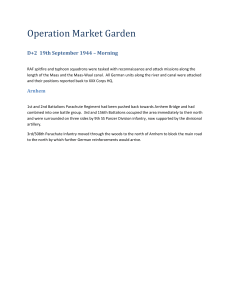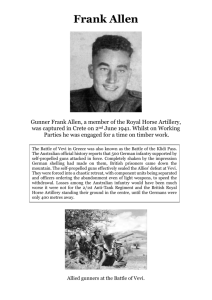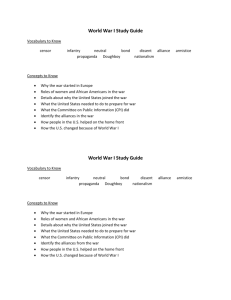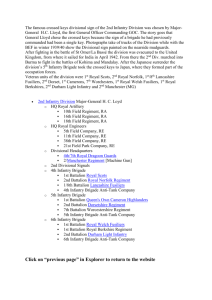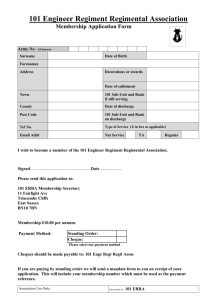a copy of this report in Microsoft Word format
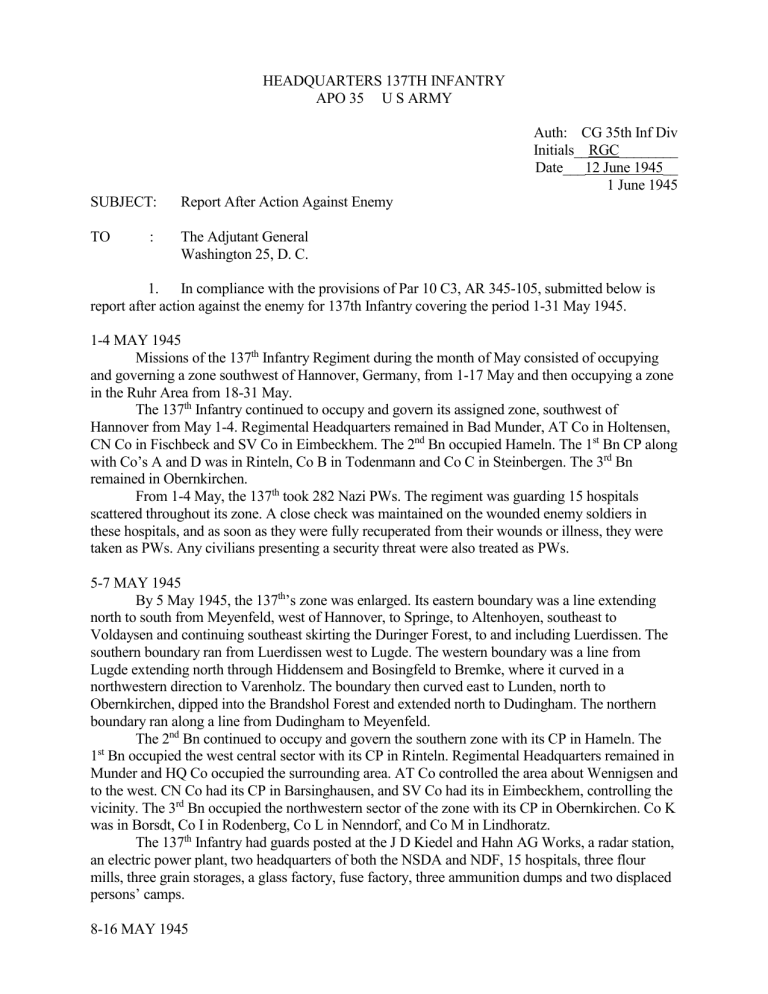
HEADQUARTERS 137TH INFANTRY
APO 35 U S ARMY
Auth: CG 35th Inf Div
Initials__RGC________
Date___12 June 1945__
1 June 1945
SUBJECT: Report After Action Against Enemy
TO : The Adjutant General
Washington 25, D. C.
1. In compliance with the provisions of Par 10 C3, AR 345-105, submitted below is report after action against the enemy for 137th Infantry covering the period 1-31 May 1945.
1-4 MAY 1945
Missions of the 137 th
Infantry Regiment during the month of May consisted of occupying and governing a zone southwest of Hannover, Germany, from 1-17 May and then occupying a zone in the Ruhr Area from 18-31 May.
The 137 th
Infantry continued to occupy and govern its assigned zone, southwest of
Hannover from May 1-4. Regimental Headquarters remained in Bad Munder, AT Co in Holtensen,
CN Co in Fischbeck and SV Co in Eimbeckhem. The 2 nd
Bn occupied Hameln. The 1 st
Bn CP along with Co’s A and D was in Rinteln, Co B in Todenmann and Co C in Steinbergen. The 3 rd
Bn remained in Obernkirchen.
From 1-4 May, the 137 th
took 282 Nazi PWs. The regiment was guarding 15 hospitals scattered throughout its zone. A close check was maintained on the wounded enemy soldiers in these hospitals, and as soon as they were fully recuperated from their wounds or illness, they were taken as PWs. Any civilians presenting a security threat were also treated as PWs.
5-7 MAY 1945
By 5 May 1945, the 137 th ’s zone was enlarged. Its eastern boundary was a line extending north to south from Meyenfeld, west of Hannover, to Springe, to Altenhoyen, southeast to
Voldaysen and continuing southeast skirting the Duringer Forest, to and including Luerdissen. The southern boundary ran from Luerdissen west to Lugde. The western boundary was a line from
Lugde extending north through Hiddensem and Bosingfeld to Bremke, where it curved in a northwestern direction to Varenholz. The boundary then curved east to Lunden, north to
Obernkirchen, dipped into the Brandshol Forest and extended north to Dudingham. The northern boundary ran along a line from Dudingham to Meyenfeld.
The 2 nd
Bn continued to occupy and govern the southern zone with its CP in Hameln. The
1 st
Bn occupied the west central sector with its CP in Rinteln. Regimental Headquarters remained in
Munder and HQ Co occupied the surrounding area. AT Co controlled the area about Wennigsen and to the west. CN Co had its CP in Barsinghausen, and SV Co had its in Eimbeckhem, controlling the vicinity. The 3 rd
Bn occupied the northwestern sector of the zone with its CP in Obernkirchen. Co K was in Borsdt, Co I in Rodenberg, Co L in Nenndorf, and Co M in Lindhoratz.
The 137 th
Infantry had guards posted at the J D Kiedel and Hahn AG Works, a radar station, an electric power plant, two headquarters of both the NSDA and NDF, 15 hospitals, three flour mills, three grain storages, a glass factory, fuse factory, three ammunition dumps and two displaced persons’ camps.
8-16 MAY 1945
The 137 th Infantry continued to occupy and govern its assigned zone south of Hannover,
Germany from 8-16 May 1945.
The 3 rd
Bn moved its CP from Obernkirchen to Bokeloh on 14 May. The companies remained in their original towns. The 1 st Bn with its CP in Rinteln, had Co A in the vicinity of
Rinteln, Co D south and southeast of Rinteln, Co B west of Hameln, and Co C northwest of Hameln as far as the autobahn superhighway, which ran through the regimental zone.
The sector extending south from Hameln was taken over by the 60 th
Engr Bn.
17-18-MAY 1945
The 137 th
Infantry turned over responsibilities for its zone to the 335 th
Infantry, 84 th
Infantry
Division prior to 2400, 17 May. On the morning of 18 May, the regiment moved by motor 110 miles from its IP in Hameln westward to the Ruhr Area, in the vicinity of Recklinghausen, and relieved the 377 th
Infantry of the 79 th
Division.
The route taken by the 137 th was from Hameln southwest through Bromberg, Hon,
Padeborn and Gesche, then west to Bochum and north through Herne and Recklinghausen to its new zone of occupation. The entire regiment closed into the area by 1555, 18 May.
19-31 MAY 1945
The 137 th
Infantry occupied approximately 400 square miles of the Ruhr from 19-31 May
1945. The southern boundary of the zone was but a few miles north of Essen and extended south of the autobahn highway from Bottrop east to Heprichenburg. The zone extended as far north as
Roesfeld and east to Wassendorf to a point west of Dulmen. It included over 135 cities and towns, the densely populated being Gelsenkirchen, Bottrop, Recklinghausen, Dorsten and Haltern.
Regimental Headquarters was located south of Herten and the autobahn, AT Co in Herten,
CN Co in Dreul Nord, and SV Co in Stickenbusch. The 1 st
Bn CP was in Bottrop along with Co A and Co C. Co B was in Gladbeck and Co D in Kirchhellen. The 2 nd
Bn CP was located in Buer, Co
E in Marl, Co F in Gelsenkirchen, Co G in Buer Erle and Co H in Herten. The 3 rd
Bn CP was in
Waltrop with Co I while Co K was in Oer-Erken-Schwick, Co L in General Blumenthal and Co M in Recklinghausen. The 547 th
AAA AW Bn was attached to the 137 th
Infantry in this zone. It occupied the northernmost sector of the zone and had its CP in Hullern.
The 137 th posted guards on 55 Displaced Persons’ camps containing some 44,000 Russians,
Poles, Dutch, Italians, French and Belgians along with 23 camps holding 7,290 ex-Allied PWs. The civilian population according to the Military Government amounted to one million people. Also under guard were six German military hospitals, a synthetic rubber plant, and all bridges in the zone.
In this zone, a transportation difficulty was encountered by the regiment. This difficulty was overcome by assigning CN Co and AT Co installations to guard, so that their transportation could be utilized.
The civilian population was allowed on the streets from 0500 to 2100 daily. Vehicles could be driven by the Germans, only if the Military Government had issued a permit for such. During the allotted hours, the civilians could circulate undisturbed anywhere in the 35 th Division zone without being disturbed. All schools and post offices remained closed.
Probably the biggest problem throughout the Ruhr is the lack of food. The congested industrial districts offer little garden space which is prevalent elsewhere in most sections of
Germany. The German civilians received scant rations while the Displaced Persons’ were being fed through the U.S. Army.
The problem of renewing public utilities in this zone was already solved when the 137 th began occupation. Electricity and running water were provided throughout the zone.
There were no Battle Casualties for the month of May.
Awards received by members of the 137 th Infantry for the month of May are as follows:
Silver Star Bronze Star
Officers
Reg OLC Reg OLC
2 0
Enlisted Men 9 0
8
53
1
6
The number of Purple Heart Medals awarded is: 10.
W. S. MURRAY
Colonel, Infantry
Commanding
Incl:
Journal and Supporting Papers

